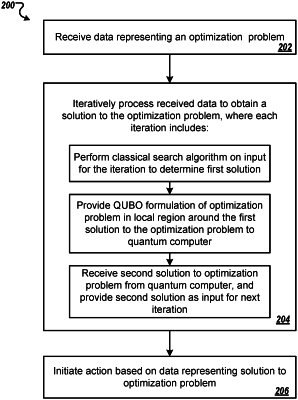| CPC A61N 5/1031 (2013.01) [G05B 19/4155 (2013.01); G06F 16/2425 (2019.01); G06F 17/11 (2013.01); G06N 10/00 (2019.01); G06N 10/60 (2022.01); G16H 20/40 (2018.01); G16H 40/40 (2018.01); G16H 50/20 (2018.01); G16H 50/30 (2018.01); G16H 50/70 (2018.01); A61N 5/1045 (2013.01); G05B 2219/45117 (2013.01)] | 18 Claims |

|
1. A computer-implemented method comprising:
receiving data relating to an optimization problem, wherein the optimization problem comprises an objective function to be optimized over multiple problem parameters;
iteratively processing, until termination criteria are met, the received data relating to the optimization problem to obtain data representing a solution to the optimization problem, comprising, for each iteration:
performing a classical search algorithm on an input for the iteration to determine a first solution to the optimization problem;
providing data relating to the first solution to the optimization problem to a quantum computing resource, wherein the data relating to the first solution to the optimization problem comprises a quadratic unconstrained binary optimization (QUBO) formulation of the optimization problem in a local region around the first solution to the optimization problem;
generating the quadratic unconstrained binary optimization (QUBO) formulation of the optimization problem in the local region around the first solution to the optimization problem, comprising:
selecting a discretization for the optimization problem;
applying the discretization to the optimization problem to obtain discretized values of the multiple problem parameters, wherein each discretized value comprises a respective binary sequence; and
determining a binary sequence corresponding to a discretization of the first solution to the optimization task;
obtaining data relating to a second solution to the optimization problem from the quantum computing resource; and
providing the data relating to the second solution to the optimization problem as input to a subsequent iteration;
receiving solution data from the processing; and
initiating an action based on the solution data.
|